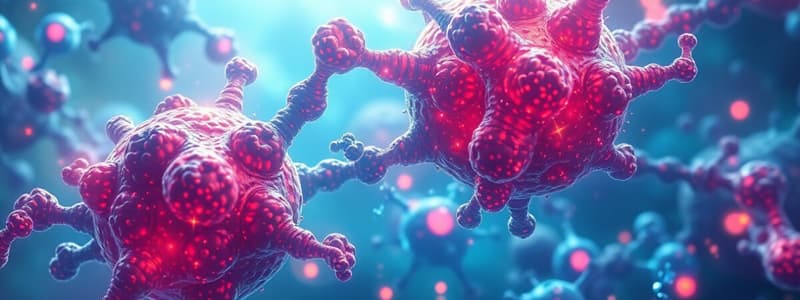Podcast
Questions and Answers
What is the primary function of enzymes in the body?
What is the primary function of enzymes in the body?
- To slow down chemical reactions
- To expedite chemical reactions (correct)
- To change the energy levels of reactions
- To act as substrates for reactions
What do we call the model that describes how a substrate fits into an enzyme's active site like a key into a lock?
What do we call the model that describes how a substrate fits into an enzyme's active site like a key into a lock?
- The Induced Fit Model
- The Enzyme-Substrate Model
- The Lock and Key Model (correct)
- The Catalytic Model
Which stage occurs after the enzyme-substrate complex forms?
Which stage occurs after the enzyme-substrate complex forms?
- The substrate is released unchanged
- The products are produced (correct)
- The reaction slows down
- The enzyme is recycled
What type of molecules can serve as cofactors for enzymes?
What type of molecules can serve as cofactors for enzymes?
What happens to an enzyme after it catalyzes a reaction?
What happens to an enzyme after it catalyzes a reaction?
Which model states that the binding of a substrate induces a change in the active site of the enzyme?
Which model states that the binding of a substrate induces a change in the active site of the enzyme?
What is the name given to the complex formed when the enzyme and substrate bind?
What is the name given to the complex formed when the enzyme and substrate bind?
What is a shared characteristic of enzymes?
What is a shared characteristic of enzymes?
What suffix is commonly added to the name of an enzyme based on its substrate?
What suffix is commonly added to the name of an enzyme based on its substrate?
Which of the following factors does not influence enzyme action?
Which of the following factors does not influence enzyme action?
What is the correct order for the enzyme classification system?
What is the correct order for the enzyme classification system?
Which of the following enzymes is responsible for breaking down proteins?
Which of the following enzymes is responsible for breaking down proteins?
Which of the following represents the sub-sub class for an enzyme acting on the CH-OH group of donors with NADP+ as an acceptor?
Which of the following represents the sub-sub class for an enzyme acting on the CH-OH group of donors with NADP+ as an acceptor?
Flashcards are hidden until you start studying
Study Notes
Importance of Enzymes
- Enzymes are complex organic compounds crucial for speeding up chemical reactions in the body without changing themselves.
- Specificity is a key feature; each enzyme catalyzes one specific chemical reaction, enhancing reaction rates significantly.
Structure and Function
- Enzymes consist of active sites, where substrates bind, forming an enzyme-substrate complex.
- The reaction proceeds, transforming substrates into products, which are then released while the enzyme remains unchanged.
Models of Enzyme Action
- Lock and Key Model: Proposed by Emil Fischer, suggesting a rigid fit between substrate and enzyme, like a key in a lock.
- Induced Fit Model: Proposed by Daniel E. Koshland Jr., indicating that substrate binding induces conformational changes in the enzyme, facilitating the reaction.
Coenzymes and Cofactors
- Coenzymes are organic molecules that assist enzymes and bind loosely to them.
- Cofactors can be inorganic or organic and assist in substrate recruitment without permanent binding.
Enzyme Nomenclature
- Enzyme names often end in -ase, derived from either the substrate (e.g., lactase from lactose) or the type of reaction (e.g., oxidase).
- The systematic nomenclature includes the EC number, indicating enzyme class, subclass, and specific enzyme identity.
Biological Enzyme Examples
- Lipase: Breaks down fats.
- Protease: Breaks down proteins.
- Cellulase: Breaks down cellulose.
- Amylase: Breaks down starch.
- Sucrase: Breaks down sucrose.
- Maltase: Breaks down maltose.
- Lactase: Breaks down lactose.
Factors Influencing Enzyme Action
- Concentration of substrates and enzymes affect reaction rates.
- Temperature and pH levels can optimize or hinder enzyme effectiveness.
- Presence of accelerators can enhance enzyme action, while inhibitors can slow it down or stop it.
- Environmental hazards may negatively impact enzyme function.
Studying That Suits You
Use AI to generate personalized quizzes and flashcards to suit your learning preferences.



